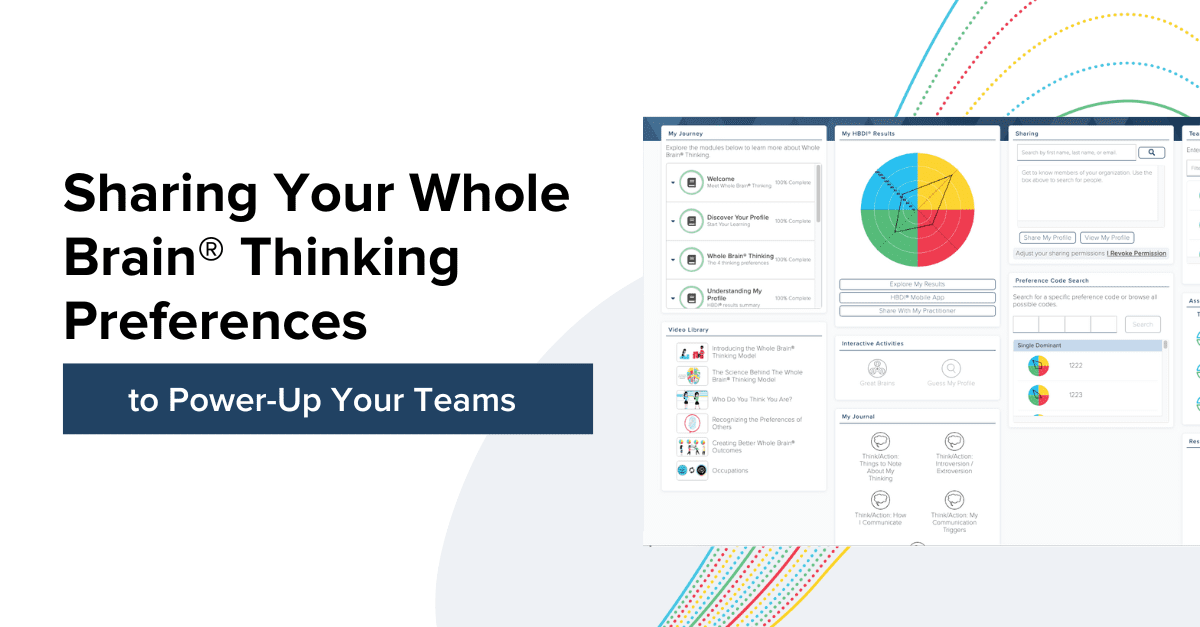Throughout my career, I’ve found that one of the most rewarding and challenging aspects of the work I do is the people I work with.
Interacting with other people and teams is highly rewarding because of the significant results we produce when we work together - but those interactions are also challenging. People are complex, and it can sometimes be tough navigating interactions with colleagues and teams.
Fortunately, I’ve found that Whole Brain® Thinking can help you and the people you work with understand each other so that you can work together to produce some significant results - especially when HBDI® profiles are shared.
Why Share Your HBDI® Profile
Telling your coworkers about your thinking preferences is a great way to connect and collaborate more effectively. People can’t read each other’s minds - but with shared HBDI® profiles, they can make their thinking visible.
In the Herrmann platform, you can share your HBDI® results to generate shared understanding, and you can personalize those results to provide even more useful guidance on how to work most effectively with you.
Here’s a look at how personalizing and sharing your HBDI® profile can help you improve communication, solve problems, and make decisions.
Improve Communication
In my role as a business analyst and product manager, I communicate with a wide range of people inside and outside of my organization - and I’ve found that those people have wildly different ways of communicating.
Because I am so reliant on effective communication, I often end up adjusting to everyone else’s preferred communication style. That means if I’m working with someone who prefers to “think out loud,” I’ll give them room to talk through their thoughts - even though I’d much rather just have them write up their ideas in a well-crafted email.
Of course, constantly adjusting to others’ communication preferences makes me hungry for the opportunity to tell others how I prefer to communicate.
With personalized HBDI® results, I can make it clear how I like to communicate and give the people I’m working with a chance to explain their preferred mode of communication. With that shared understanding, we can work together to figure out the best way for us to communicate.
Sign up to our newsletter for the latest insights

Personalizing and sharing your communication preferences leads to more effective information sharing, and fewer misunderstandings. For example, if people realize that I naturally prefer written communication, then they’ll be more understanding when I don’t initiate a call.
Solve Problems
The most effective way to solve problems is to get a cognitively diverse group of people looking at the problem from a variety of different angles. Of course, along with those different perspectives come different preferences for how to solve problems.
These differences can be a great asset to your team as long as you’re aware of everyone’s preferred way of solving problems and can make sure that you balance those preferences effectively.
For example, when I work with a team, I’ll take a step-by-step, logical approach to solving a problem, and I might overlook new ideas or fail to consider team processes.
If there’s someone else in the group that prefers approaches I tend to overlook, we’d make a great team that balances each other out - as long as we’re aware of our different preferences and will find an approach that makes use of each of our individual preferences.
Make Decisions
With decision-making, we all have different questions we ask to reach a conclusion. We also have different perspectives on whether decisions are best made by a single person with input from others, or if it’s better for a group to decide.
Understanding your thinking preference and those of the people you work with will help you figure out the decision-making approach that will work best for your group.
I, for example, focus on whether we have all the facts, but may not be as inclined to consider how the decision affects others, or what other people’s opinions are. My perspective is that a single person should decide, but who that person is changes depending on what the decision is about.
When everyone on a team shares their thinking preferences, we’re able to identify the questions each member will ask when making a decision, and try to proactively provide the information they’re looking to gather. That way, we’re able to make sure that everyone is informed and included in the decision-making process.
When to personalize and share your HBDI® profile
Hopefully, you can see the value in personalizing and sharing your HBDI® profile with the people you work with regularly.
Sharing takes time, so it’s helpful to identify specific points where sharing your profile makes the most sense. I’d suggest personalizing and sharing thinking preferences:
To improve a 1:1 collaboration
During your work, there are going to be certain people you work with all the time, whether a peer, direct report, or your manager. There will also be times when you need to partner with someone you don’t know well. Both of these scenarios are great opportunities to share your thinking in order to identify blindspots and opportunities for synergy.
Whether you’re working with a new collaborator or someone you’ve known for a long time, sharing your thinking preferences can help you deliver more than you can each do on your own. Sharing can help ensure effective communication, decision-making, and problem solving. Reviewing each other’s HBDI® profiles and discussing how to use that information to strengthen your working relationship can be a powerful exercise for longtime and brand new collaborators.
I once worked in the IT department of a health insurance company. My team worked on a series of projects that affected the underwriting and actuarial team, which made the Director of Actuary a key stakeholder. Based on her previous experience with IT projects, she was skeptical of the impact that my projects would have on her operations. Right away, I could tell there was a lack of trust that we would have to overcome in order to be successful in our collaboration.
I needed to have a good working relationship with the Director of Actuary, so I had to find some way to build trust with her. Fortunately, we had both done the HBDI® assessment and had walked through the journey to get insights into our own thinking preferences. We shared our profiles with each other and paid close attention to the Building Trust section.
This helped us understand each other better and build a stronger relationship in the future.
To improve the effectiveness of your team
Teams are at the core of your organization's productivity. Whether you’re part of a longstanding team, a short-lived ad hoc team, or both, the better everyone understands each other’s thinking preferences the more effective your team will be.
There are a few occasions where it makes sense for team members to personalize and share their Thinker profiles.
When you start working together as a team, have everyone share their Thinker profiles as part of a kickoff meeting.
You can share the About Me section of your profile as a quick way to learn about your teammates.
You can use the Frustrations part of your profile to help your team to identify shared working agreements. When you understand what specifically frustrates each member of the team, you can agree to avoid those behaviors as much as possible when working as a team.
You can also use the Communication and General Description sections to provide insight into how each team member prefers to communicate, their approach to solving problems, and what they consider when making decisions.
How to personalize your HBDI® profile
Your HBDI® results provide great insight into your thinking preferences and those of your team members. When you build upon those results with personal reflection, you can get to know yourself better and put together information that will help others work with you more effectively.
There are a variety of ways you can personalize your HBDI® profile.
Journey
Once you’ve completed your journey e-learning activities and unlocked your HBDI® results, you’ll go through a series of activities to personalize your HBDI® profile.
This process allows you to think through the many facets of your thinking preferences and how those preferences can affect your interactions with others.
As you walk through the various sections, you can decide whether to include that information on the publicly accessible view of your profile or if you want to hide it from public view.
Journal
If you want to edit the personalized sections of your profile, use the My Journal tile in the Thinker Portal to go directly to the different profile sections..
In each section, you can edit your reflections and decide whether that section is available on your profile when you share it with others.
Sharing
Finally, you can view your profile as others will see it by going to the Sharing tile and selecting View My Profile.
On the About Me, Introversion/Extroversion, Communication, Frustrations, and Building Trust tabs you can see your personalized information as others will see it, edit that content, and choose what to include or hide on your shared profile..
How to share your HBDI® profile
Share your own profile so that others can learn about your thinking preferences and how best to work with you. Use the insights you have gained from your journey to help people understand you, to describe your preferences in more depth, and to help others better communicate and build trust with you.
You can share your profile from the Sharing tile on the homepage and clicking the "Share My Profile" button.
Once you grant sharing access to your profile, you can provide your personal shared link to other people in your organization - or you can also share your profile directly by email.
Next steps
Sharing your Whole Brain® Thinking preferences can be a great way to help colleagues collaborate with you most effectively. Letting people know how you like to communicate, what frustrates you, and how you prefer to build trust accelerates the teaming process and helps everyone get further faster.
Here are three quick actions you can take to share your thinking:
- Personalize your HBDI® profile in the Herrmann platform.
- Grant access to your shared profile so others in your organization can view your Whole Brain® Thinking preferences.
- Use shared profiles in an upcoming team meeting to discuss communication, decision-making, and trust-building preferences.
As a bonus, if your organization is using Herrmann’s Stop & Think app in Microsoft Teams - you can also share your thinking with your teams in the flow of work - along with tips and templates to maximize your team’s cognitive diversity.
Resources
For added support on sharing your HBDI® profile, check out:












